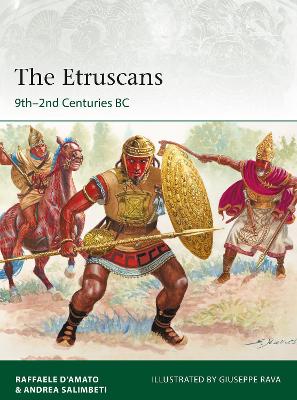Elite
2 primary works
Book 223
Ancient Rome had deep roots in the 'Villanovan' culture that we call today the Etruscans. Their long-lived civilization can be traced to 900-750 BC in north-west Italy. They were a sea-faring people trading with and competing against Greek and Phoenician peoples, including the Carthaginians. They were also a great land-based power, especially in the 'Classical' period, where they expanded their power north into the Po Valley and south to Latium. In the 6th century BC an Etruscan dynasty ruled Rome, and their power extended southwards to the Amalfi coast. In 509 BC the Romans rose up to expel their kings, which began the long 'Etruscan twilight' when their power was squeezed by the Samnites and, most especially, the Romans.
Drawing on archaeological evidence including warrior tombs, paintings, sculptures, and fully illustrated throughout, this study examines one of the early rivals to Ancient Rome.
Drawing on archaeological evidence including warrior tombs, paintings, sculptures, and fully illustrated throughout, this study examines one of the early rivals to Ancient Rome.
Book 230
The Late Roman Empire was a period of significant change in the designs of standards and in the costumes of standard-bearers. During the middle decades of the chaotic 3rd century, evidence confirms the continued use of the old legionary eagle and the signa of the old cohorts and centuries, alongside flags and Imperial images. The two major trends over the later generations were the adoption of Christian symbols on standards (e.g. Constantine the Great's Chi-Rho), and the proliferation of different types of flags. This had begun in the late 2nd century with the adoption of the 'barbarian' dragon standard, the windsock-shaped draco, which continued to be displayed alongside various other flags in the Greek-speaking Eastern Empire, whose influence increased greatly. Meanwhile, the growing employment of foreign units was such that by the 5th century we have evidence of the use of Hunnic symbolism among a Roman general's suite of standards. The costumes of standard-bearers also evolved as 'Persian' styles spread from Constantinople.
This title explores all these changes in depth, charting the development of various costumes and designs and the waxing and waning influence of various cultures and religious considerations. The text is supported by specially commissioned illustrations and artist's reconstructions of the standards and their bearers.
This title explores all these changes in depth, charting the development of various costumes and designs and the waxing and waning influence of various cultures and religious considerations. The text is supported by specially commissioned illustrations and artist's reconstructions of the standards and their bearers.

